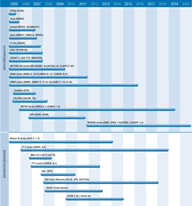Cloud particle properties and profile
A key to predicting climate change is to observe and understand the global distribution of clouds, their physical properties, such as thickness and droplet size, and their relationship to regional and global climate. Whether a particular cloud will heat or cool the Earth's surface depends on several factors, including the cloud's altitude, its size, and the make-up of the particles which form the cloud.
Because clouds change rapidly over short time and space intervals, they are difficult to quantify. Full 3-D observations of cloud structure from space are still in development, with the first sensors expected with a few years on NASA (CloudSat) and ESA missions. These missions will be capable of measuring the vertical structure of a large fraction of clouds and precipitation - from very thin cirrus clouds to thunderstorms producing heavy precipitation.
Currently, basic information on the structure of clouds (ie determination of whether water or ice particles are present) is being obtained from microwave instruments such as AMSR-E on Aqua. MODIS and MISR on Terra also provide observations which enable estimates of cloud droplet size to be made. These measurements are important for climate purposes as the structure of clouds (particle size and phase) greatly affects their optical properties and hence their albedo. Together with cloud top temperatures, information on the 3-D structure of clouds can be used as a basic tool for the real time surveillance of features such as thunderstorms. Study of these parameters through the life cycle of a storm allows researchers to develop useful short term forecasting criteria.
Additional phase information will also be available from polarimetric radiometers such as POLDER. However, the users’ requirements for cloud data are unlikely to be met until data from instruments such as ATLID or the cloud radars become available.
In a fine example of international co-operation, from April 2005 a multiple satellite constellation comprising CloudSat, Aqua, Aura, CALIPSO and PARASOL will fly in orbital formation with the goal of gathering data needed to evaluate and improve the way clouds are represented in global models, and to develop a more complete knowledge of their poorly understood role in climate change and the cloud-climate feedback. CloudSat will maintain a tight formation with CALIPSO, with a goal of overlapping measurement footprints at least 50% of the time. CALIPSO will carry a dual-wavelength polarisation-sensitive lidar that provides high resolution vertical profiles of aerosols and clouds. CloudSat and CALIPSO will maintain a somewhat looser formation behind Aqua - which carries a variety of passive microwave, infrared, and optical instruments.

